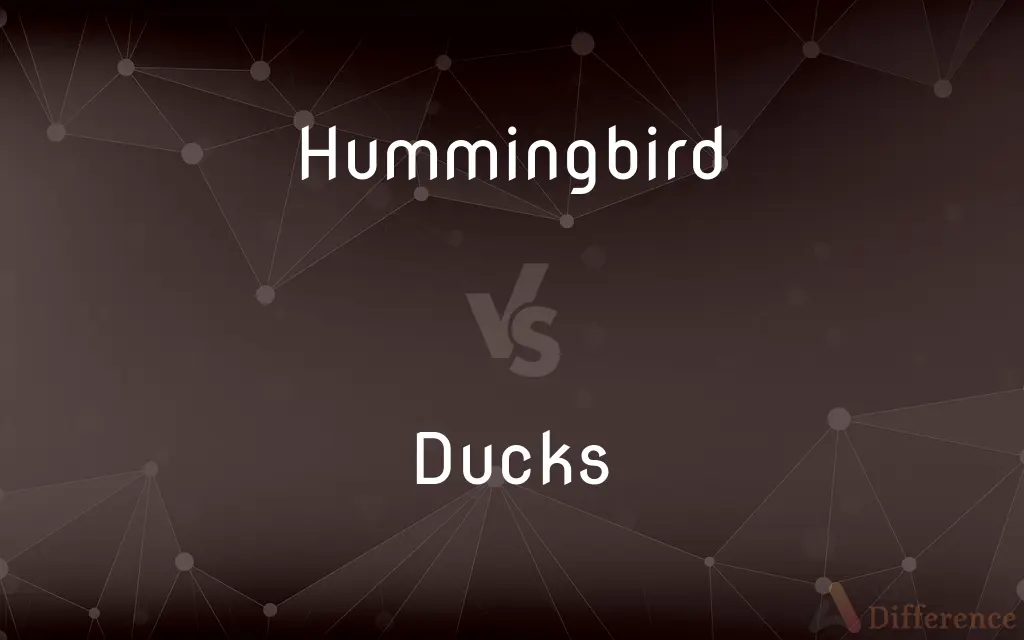Hummingbird vs. Ducks — What's the Difference?
By Fiza Rafique & Maham Liaqat — Updated on March 26, 2024
Hummingbirds are tiny, agile birds known for their ability to hover, while ducks are larger, waterfowl known for their swimming abilities.

Difference Between Hummingbird and Ducks
Table of Contents
ADVERTISEMENT
Key Differences
Hummingbirds are renowned for their diminutive size and remarkable hovering flight, achieved by rapid wing flapping. They are attracted to brightly colored flowers for nectar, which is crucial for their high-energy lifestyle. On the other hand, ducks are generally larger, with a body adapted for aquatic environments. They have webbed feet for efficient swimming and are often seen floating on water or foraging along shorelines.
While hummingbirds possess a unique ball-and-socket joint at the shoulder that allows their wings to rotate 180 degrees in all directions, enabling precise aerial maneuvers and the ability to fly backwards, ducks have stronger, broader wings that are more adapted for long-distance flight and quick takeoffs from water surfaces. This difference in wing structure underlines the distinct flight capabilities and lifestyles of each bird.
Hummingbirds are solitary creatures, coming together only during mating season. Their interactions are often competitive, especially around food sources. Ducks, in contrast, are more social birds, frequently found in groups or pairs, and exhibit a wide range of social behaviors, from feeding to migration.
Regarding diet, hummingbirds primarily feed on nectar from flowers, supplemented by insects and spiders for protein. This diet supports their rapid wing movement and high metabolic rate. Ducks have a more varied diet, consuming aquatic plants, small fish, insects, and even algae, reflecting their adaptability to different environmental conditions.
In terms of habitat, hummingbirds are mostly found in the Americas, from Alaska to Tierra del Fuego, with a high concentration in tropical and subtropical regions. They prefer areas rich in flowers that provide nectar. Ducks are more widely distributed globally, inhabiting a variety of freshwater and saltwater environments, from small ponds and marshes to large lakes and coastal shorelines, showcasing their versatility in adapting to different habitats.
ADVERTISEMENT
Comparison Chart
Size & Body Shape
Extremely small with lightweight, streamlined bodies
Larger with a heavier body adapted for water
Flight
Can hover in place; agile and can fly backwards
Strong, straight flight; can take off vertically from water
Social Behavior
Solitary except during mating; competitive around food sources
Social, often found in groups; cooperative in certain behaviors
Diet
Primarily nectar, supplemented with insects and spiders
Varied, including aquatic plants, fish, insects, and algae
Habitat
Mostly in the Americas, preferring areas rich in flowers
Globally distributed, in freshwater and saltwater environments
Compare with Definitions
Hummingbird
They are the only birds capable of flying backwards.
Hummingbirds can instantly change direction during flight to escape predators.
Ducks
Ducks are generally social birds, often seen in flocks.
A group of ducks on a lake is called a raft.
Hummingbird
Hummingbirds are the smallest migrating birds, known for their ability to hover in mid-air.
The ruby-throated hummingbird can flap its wings about 50 times a second.
Ducks
Many duck species migrate seasonally to exploit different breeding and feeding grounds.
Northern pintails migrate thousands of miles between breeding and wintering sites.
Hummingbird
They have an extremely high metabolism that requires them to eat half their body weight in sugar daily.
A hummingbird visits hundreds of flowers each day to get enough nectar.
Ducks
Ducks are adapted to live in water with webbed feet for swimming.
Mallards are often seen dabbling for food in ponds.
Hummingbird
Hummingbirds often display iridescent feathers that can change color in different angles of light.
The throat of a male Anna’s hummingbird shines a brilliant emerald green in the sunlight.
Ducks
They have a diverse diet ranging from aquatic plants to small fish.
Diving ducks hunt for food deeper than dabbling ducks.
Hummingbird
Outside of breeding, hummingbirds are solitary and territorial.
A hummingbird aggressively defends its territory from other birds.
Ducks
A plunge under water.
Hummingbird
Hummingbirds are birds native to the Americas and comprise the biological family Trochilidae. With about 360 species, they occur from Alaska to Tierra del Fuego, but the vast majority of the species is found in the tropics.
Ducks
Ducks are known for their wide range of vocalizations.
Female mallards are especially noisy with their characteristic quack.
Hummingbird
Any of numerous birds of the family Trochilidae found throughout the Americas, usually very small in size and having brilliant iridescent plumage, a long slender bill, and wings capable of beating very rapidly, thereby enabling the bird to hover.
Ducks
Any of various wild or domesticated waterbirds of the family Anatidae, characteristically having a broad flat bill, short legs, and webbed feet.
Hummingbird
Any of various small American birds in the family Trochilidae that have the ability to hover.
Ducks
A female duck.
Hummingbird
Any bird of the family Trochilidæ, of which over one hundred genera are known, including about four hundred species. They are found only in America and are most abundant in the tropics. They are mostly of very small size with long slender bills adapted to sucking nectar from flowers, and are noted for the very brilliant iridescent colors of their plumage and their peculiar habit of hovering about flowers while vibrating their wings very rapidly with a humming noise; the wings are specialized for hovering flight, but they can also dart forward and fly quite rapidly. They feed both upon the nectar of flowers and upon small insects. The common humming bird or ruby-throat of the Eastern United States is Trochilus colubris. Several other species are found in the Western United States. See Calliope, and Ruby-throat.
Ducks
The flesh of a duck used as food.
Hummingbird
Tiny American bird having brilliant iridescent plumage and long slender bills; wings are specialized for vibrating flight
Ducks
(Slang) A person, especially one thought of as peculiar.
Ducks
Often ducks (used with a sing. verb) Chiefly British A dear.
Ducks
A quick lowering of the head or body.
Ducks
A durable, closely woven heavy cotton or linen fabric.
Ducks
Ducks Clothing made of duck, especially white pants.
Ducks
An amphibious military truck used during World War II.
Ducks
A similar vehicle used for civilian purposes, as to evacuate flood victims or for sightseeing tours. In both senses also called DUKW.
Ducks
To lower quickly, especially so as to avoid something
Ducked his head as the ball came toward him.
Ducks
To evade; dodge
Duck responsibility.
Ducked the reporter's question.
Ducks
To push (a person, for example) suddenly under water.
Ducks
In bridge, to deliberately play a card that is lower than (an opponent's card).
Ducks
To lower the head or body.
Ducks
To move swiftly, especially so as to escape being seen
Ducked behind a bush.
Ducks
To submerge the head or body briefly in water.
Ducks
To evade a responsibility or obligation. Often used with out
Duck out on one's family.
Ducks
In bridge, to lose a trick by deliberately playing lower than one's opponent.
Ducks
(poker slang) A pair of twos.
Ducks
Dear (used as a pet name).
Hello ducks, how are you today?
Ducks
(nautical) The light trousers worn by sailors in hot climates.
Common Curiosities
What makes hummingbirds able to hover?
Hummingbirds can hover due to their unique wing structure, allowing them to flap their wings in a figure-eight motion.
What is the primary diet of a hummingbird?
The primary diet of hummingbirds is nectar, which provides the necessary energy for their high metabolism.
How do ducks stay afloat?
Ducks have buoyant bodies and secrete an oil that helps keep their feathers waterproof, aiding in flotation.
Are hummingbirds found worldwide?
No, hummingbirds are native to the Americas and are not found naturally elsewhere.
What is a group of ducks called?
A group of ducks can be called a flock, raft, team, or paddling.
How fast can hummingbirds flap their wings?
Some species can flap their wings up to 80 times per second in a hovering flight.
What is the lifespan of a hummingbird?
Hummingbirds can live up to 5 years or more in the wild, depending on the species.
How do hummingbirds feed?
They feed by using their long, specialized beaks to reach nectar inside flowers.
Where do ducks nest?
Ducks usually nest on the ground near water bodies but can also use nest boxes or platforms provided by humans.
Can ducks fly as well as swim?
Yes, ducks are proficient flyers capable of long-distance migrations, in addition to being excellent swimmers.
Do ducks have any natural predators?
Yes, ducks are preyed upon by various animals, including foxes, large fish, and birds of prey.
How do ducks communicate?
Ducks use a variety of sounds and body movements to communicate with each other.
Can all ducks quack?
No, not all ducks quack. For example, male ducks (drakes) are generally quieter, and some species have different sounds.
What colors can hummingbirds be?
Hummingbirds display a wide range of colors, often with iridescent feathers that can shimmer in sunlight.
Do hummingbirds migrate?
Yes, many hummingbird species migrate seasonally to take advantage of flowering plants in different regions.
Share Your Discovery

Previous Comparison
Judder vs. Shudder
Next Comparison
Assumption vs. GeneralizationAuthor Spotlight
Written by
Fiza RafiqueFiza Rafique is a skilled content writer at AskDifference.com, where she meticulously refines and enhances written pieces. Drawing from her vast editorial expertise, Fiza ensures clarity, accuracy, and precision in every article. Passionate about language, she continually seeks to elevate the quality of content for readers worldwide.
Co-written by
Maham Liaqat













































